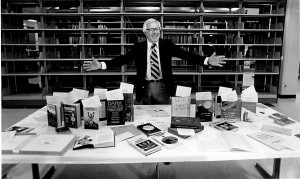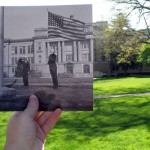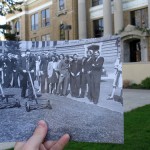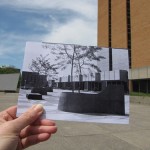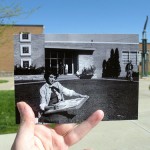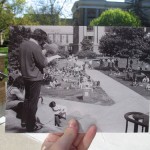Jun
6
Ray Bradbury (1920-2012)
June 6, 2012 | All, News, Rare Books/Special Collections | Leave a Comment
The BGSU library “represents all the libraries of the world to me. I’m a child of libraries. I never went to college, but I graduated from the downtown Los Angeles Library at the age of 27.”
In 1982, Ray Bradbury visited the BGSU campus for the formal presentation of a collection of his books and manuscripts to Rare Books and Special Collections. First gathered together by his friend and bibliographer William F. Nolan and added to over the years at BGSU, the collection offers a unique look at the life and work of a writer of truly international stature.
Best-known for such books as Fahrenheit 451 (1953) and The Martian Chronicles (1950), Bradbury was a prolific author of short stories, poetry, screenplays and dramas from the 1940s until his death this year. It was Bradbury’s work which raised the critical opinion of science fiction, taking it from space opera to mainstream literature. While his stories are quintessentially American, he found a world-wide audience as well–his work was translated into 36 languages.
Bradbury continued to produce new work well into his seventies and eighties including: Green Shadows, White Whale (1992) and Farewell Summer (2006).
His stories were about more than flash-and-gadgets–they were about people, about love and the imagination, about death and immortality. Throughout his life and work Bradbury maintained a wide-eyed wonder about the world which spoke to young readers and to the youth in all of us.
For more information about the Ray Bradbury Collection (MS 379), see the finding aid on our website.
May
15
Prince Principle Brings History to Life
May 15, 2012 | All, Local History, University Archives | Leave a Comment
This year in honor of National Library Week (April 8 – 14), Jerome Library held a special activity each day of the week. On Thursday, the Center for Archival Collections celebrated by bringing history to life through pictures using the Prince Principle.
The general idea of the Prince Principle is to superimpose a historical photo into the present day setting. This can be done in many ways, most simply by physically holding and lining up the historical photo with its present-day landscape.
In this way, the CAC was able to make our very own Prince Principle photos here on BGSU’s campus. The Prince Principle has become a popular trend on photo sharing sites like flickr.
One group, Looking Into the Past, has gained over 4,000 members, bringing history alive all over the world.
Another website entitled Dear Photograph is dedicated to the concept as well, allowing people to attach reminisces to their personal photos with nearly 100,000 followers between Facebook and twitter.
 A more advanced method of the Prince Principle can be done by digitally superimposing the historic photo onto the contemporary scene, allowing for a more professional look. Russian photographer Sergey Larenkov provides an excellent example of just how profound an impact the Prince Principle can have, by imposing photos of World War II on their modern-day locations. In the picture below, Larenkov took a picture of victims of a shelling from 1941 in Leningrad to contrast with St. Petersburg in 2012. His collection is truly haunting and helps to realize and make relevant the devastation from the war.
A more advanced method of the Prince Principle can be done by digitally superimposing the historic photo onto the contemporary scene, allowing for a more professional look. Russian photographer Sergey Larenkov provides an excellent example of just how profound an impact the Prince Principle can have, by imposing photos of World War II on their modern-day locations. In the picture below, Larenkov took a picture of victims of a shelling from 1941 in Leningrad to contrast with St. Petersburg in 2012. His collection is truly haunting and helps to realize and make relevant the devastation from the war.
To learn more about the Dear Photograph project, visit: http://dearphotograph.com/
To View Sergey Larenkov’s complete WWII gallery, visit: http://digg.com/newsbar/topnews/world_war_ii_photos_superimposed_over_recent_photos
At Historypin.com, users can post historic or more recent photographs, linking them to maps. See: http://www.historypin.com/
–Sarah Gluckin
Mar
13
March is Women’s History Month
March 13, 2012 | All, Local History, Uncategorized | Leave a Comment
 "Enlighten the people generally, and tyranny and oppressions of the body and mind will vanish like evil spirits at the dawn of day."
"Enlighten the people generally, and tyranny and oppressions of the body and mind will vanish like evil spirits at the dawn of day."
March is internationally recognized as Women’s History Month and International Women’s Day has been celebrated on the 8th for over 100 years. The central theme of this year’s celebration was “Connecting Girls, Inspiring Futures” and worldwide thousands of events will be held this month to support this concept as well as the over-all economic, political and social achievements of women. In this field, few organizations can boast the progress and achievements as the American Association of University Women (MS 89). The purpose of the organization is “to enable college women to continue their own intellectual growth, further the advancement of women, and discharge their responsibility to society.” Indeed, these women have worked tirelessly for over a century at the local, national, and international levels to demonstrate the change, and the good, that the educated voice of women can bring to society. The organization has 5 key areas of interest: education, international relations, community, cultural interests, and of course, women.
In regard to education, the AAUW has worked to ensure greater equality of opportunity for women and minorities on college campuses by increasing representation at all levels, from student body to faculty to administration. Additionally, they have worked to educate women about career opportunities and allow women into previously un-entered areas of the workforce. Internationally the AAUW works with the UN and the International Federation of University Women in non-governmental activities. One of the most popular and crucial programs sponsored is the African Educators Program which began in 1963 and allows “women from various African nations to visit communities in the US and to study local educational institutions.” Culturally, the AAUW has sponsored arts festivals, competitions, museums, book fairs, among many other things. One notable accomplishment was the preservation of the Antelope Valley Indian Museum through a grueling publicity and lobbying campaign for the state to purchase and continue the museum. They also worked to secure funding for educational television and ‘suitable’ prime-time television programming. Within the community the AAUW has worked to improve race relations, like civil rights legislation in the early ’60s, as well as reform in the court system and jails. In 1968 the organization released an official Call To Action pledging “the best efforts of its own members…toward constructive change to facilitate the full and equal participation of all people in the American social, economic, and political system.” They have also worked to combat poverty through legislation such as job and housing bills and school lunch and breakfast programs. Finally, they have worked to help women be elected and hold public office at every level, along with equal pay, and opportunity.
 Locally, the Bowling Green chapter of the AAUW has had a number of notable accomplishments since its founding in 1938. In line with the national goals, a number of members hold public office. They’ve also brought countless speakers to help educate and inform the public on the countless issues facing women and minorities. They’ve also held book fairs and helped sponsor countless community events. Finally, they perform the thankless task of keeping women and minority issues in public discussions helping to ensure that our voices will always continue to be heard. The Bowling Green chapter has even gained national recognition for their educational projects such as an Elder Care and Abuse study which won the Public Information Awards Competition in 1980. Other projects since include Assault on Women Prevention and AIDS Prevention in Adolescents.
Locally, the Bowling Green chapter of the AAUW has had a number of notable accomplishments since its founding in 1938. In line with the national goals, a number of members hold public office. They’ve also brought countless speakers to help educate and inform the public on the countless issues facing women and minorities. They’ve also held book fairs and helped sponsor countless community events. Finally, they perform the thankless task of keeping women and minority issues in public discussions helping to ensure that our voices will always continue to be heard. The Bowling Green chapter has even gained national recognition for their educational projects such as an Elder Care and Abuse study which won the Public Information Awards Competition in 1980. Other projects since include Assault on Women Prevention and AIDS Prevention in Adolescents.
Ultimately, the organization stands as an epitome for the need of women’s voices in the public sphere. Given equal opportunities and education, women work endlessly to not only better their own lives, and promote pertinent issues, but will work for the general welfare and true equality. As stated in 1953, we all must seek to, “widen your horizons, help build a better community, contribute toward the intelligent solution of national and international problems.”
For more information and history of the Bowling Green chapter of the AAUW come to the Center for Archival Collections to view our holdings:
http://www.bgsu.edu/colleges/library/cac/ms/page43792.html
For more information on International Women’s Day:
http://www.internationalwomensday.com/
